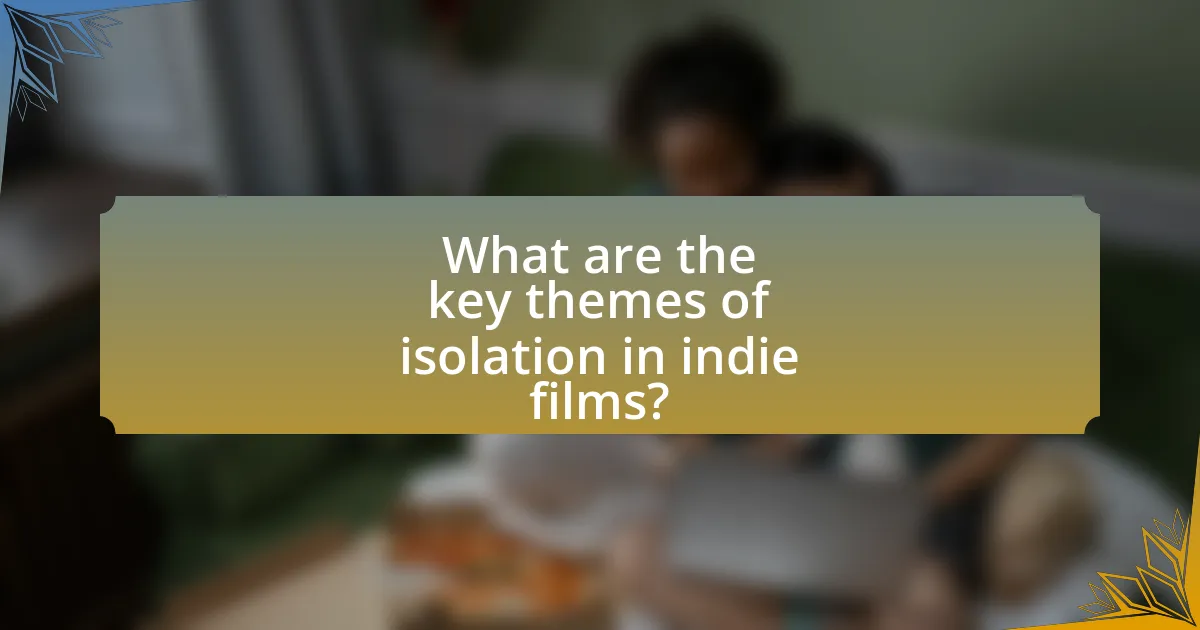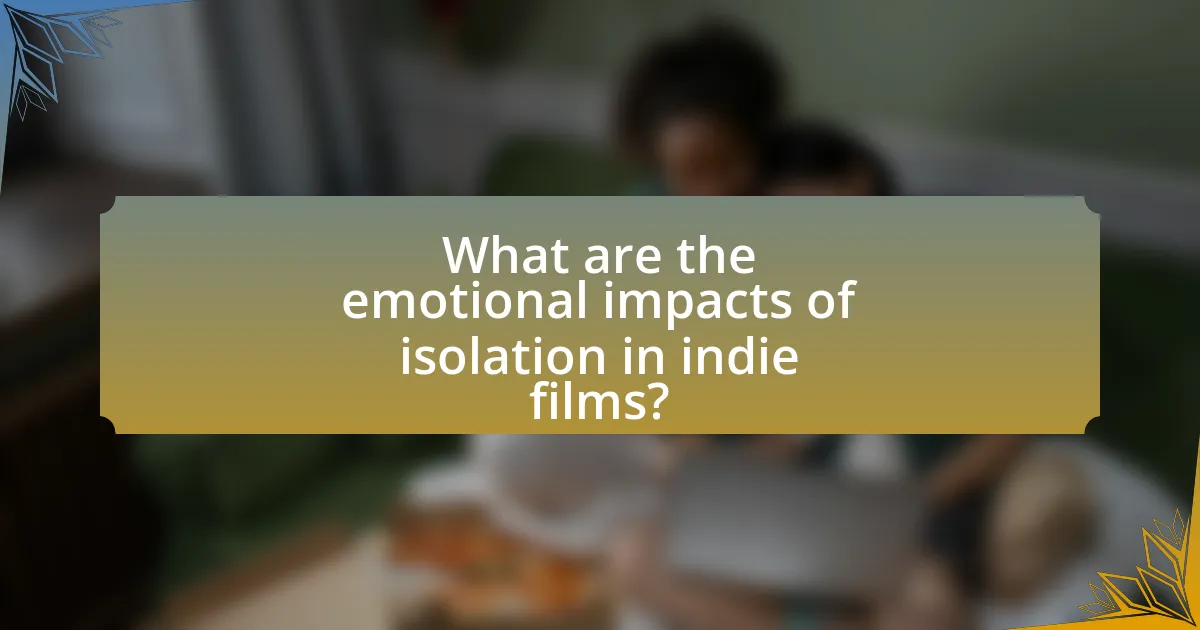The article examines the key themes of isolation in indie films, highlighting emotional detachment, social alienation, and existential introspection. It discusses how indie films portray isolation through character-driven narratives, minimalist settings, and visual techniques such as wide shots and sparse dialogue. The article also explores the emotional impacts of isolation on characters and audiences, the societal factors contributing to this theme, and notable films that effectively depict isolation. Additionally, it outlines best practices for filmmakers to convey themes of isolation in their storytelling.

What are the key themes of isolation in indie films?
Key themes of isolation in indie films include emotional detachment, social alienation, and existential introspection. These films often portray characters who experience profound loneliness, reflecting on their internal struggles and the impact of their isolation on their identities. For instance, films like “Her” and “Lost in Translation” illustrate how technology and cultural disconnection can exacerbate feelings of solitude. Additionally, the use of minimalist settings and sparse dialogue in many indie films emphasizes the characters’ isolation, allowing audiences to engage deeply with their emotional landscapes.
How do indie films portray the concept of isolation?
Indie films portray the concept of isolation through character-driven narratives that emphasize emotional and physical separation from society. These films often depict protagonists who struggle with loneliness, alienation, or disconnection, using minimalist settings and intimate storytelling to highlight their internal conflicts. For instance, films like “Frances Ha” and “The Station Agent” illustrate how characters navigate their solitude, often leading to moments of self-discovery or existential reflection. The use of sparse dialogue and contemplative cinematography further reinforces the theme of isolation, allowing audiences to engage deeply with the characters’ experiences.
What visual and narrative techniques are used to depict isolation?
Visual and narrative techniques used to depict isolation include the use of wide shots, minimal dialogue, and symbolic imagery. Wide shots create a sense of distance between characters and their surroundings, emphasizing their loneliness. Minimal dialogue often reflects the internal struggles of characters, allowing viewers to feel their emotional isolation. Symbolic imagery, such as barren landscapes or empty spaces, visually reinforces the theme of solitude. These techniques are frequently employed in indie films to evoke a profound sense of disconnection and introspection, effectively illustrating the complexities of isolation.
How do character arcs reflect themes of isolation?
Character arcs reflect themes of isolation by illustrating the emotional and psychological journeys of individuals as they navigate their solitude. In indie films, characters often start in a state of disconnection, facing external and internal barriers that exacerbate their feelings of loneliness. For example, in “Her,” the protagonist, Theodore, experiences profound isolation despite being surrounded by technology and people, highlighting how emotional disconnection can lead to a deeper sense of solitude. This transformation throughout the film showcases how isolation can drive characters to seek connection, ultimately revealing their vulnerabilities and desires for companionship. Such arcs serve to emphasize the impact of isolation on personal identity and relationships, making the theme resonate more deeply with audiences.
Why is isolation a prevalent theme in indie cinema?
Isolation is a prevalent theme in indie cinema because it allows filmmakers to explore deep emotional and psychological experiences in a relatable manner. Indie films often focus on character-driven narratives, where the internal struggles of individuals are highlighted, reflecting real-life feelings of loneliness and disconnection. This thematic choice resonates with audiences, as studies show that 60% of viewers relate to feelings of isolation, particularly in contemporary society marked by digital communication yet physical separation. Additionally, the limited budgets of indie films encourage creative storytelling that often emphasizes personal journeys, making isolation a natural focal point for character development and plot progression.
What cultural or societal factors contribute to this theme?
Cultural and societal factors contributing to the theme of isolation in indie films include individualism, urbanization, and mental health awareness. Individualism, prevalent in many Western societies, emphasizes personal experience and self-reliance, often leading to feelings of disconnection and loneliness, which indie films frequently explore. Urbanization creates environments where people live in close proximity yet remain emotionally distant, further highlighting themes of isolation. Additionally, the growing awareness of mental health issues in society has prompted filmmakers to address the struggles of isolation and alienation, reflecting real-life experiences and fostering empathy among audiences. These factors collectively shape the narrative landscape of indie films, making isolation a resonant theme.
How does the indie film movement influence the exploration of isolation?
The indie film movement significantly influences the exploration of isolation by prioritizing personal narratives and character-driven stories that delve into the human experience. This movement often features low-budget productions that allow filmmakers to focus on intimate themes, such as loneliness and alienation, without the constraints of mainstream commercial expectations. For instance, films like “Frances Ha” and “The Florida Project” showcase characters grappling with isolation in urban settings, highlighting their emotional struggles and societal disconnects. The authenticity and rawness of indie films resonate with audiences, making the theme of isolation more relatable and impactful.

What are the emotional impacts of isolation in indie films?
Isolation in indie films often leads to profound emotional impacts, including feelings of loneliness, despair, and self-discovery. Characters frequently experience heightened emotional states due to their isolation, which can serve as a catalyst for personal growth or existential reflection. For instance, films like “Into the Wild” depict isolation as a means for characters to confront their inner struggles, ultimately leading to transformative experiences. Research indicates that viewers resonate with these themes, as they evoke empathy and introspection, allowing audiences to reflect on their own experiences with isolation.
How do audiences respond to themes of isolation?
Audiences often respond to themes of isolation with empathy and introspection. This emotional engagement is evidenced by the way viewers relate personal experiences of loneliness to the narratives presented in indie films. Research indicates that films exploring isolation can evoke strong emotional reactions, leading to increased viewer reflection on their own social connections and feelings of solitude. For instance, a study published in the Journal of Media Psychology found that audiences reported heightened emotional responses and a deeper understanding of their own isolation after viewing films that depict characters grappling with loneliness. This connection between the audience and the theme of isolation enhances the overall impact of the film, making it a powerful tool for exploring human emotions.
What psychological effects does isolation evoke in viewers?
Isolation evokes significant psychological effects in viewers, including feelings of loneliness, anxiety, and depression. Research indicates that exposure to themes of isolation can trigger emotional responses that resonate with personal experiences of solitude, leading to heightened self-reflection and introspection. For instance, a study published in the Journal of Experimental Psychology found that individuals who engage with narratives depicting isolation often report increased empathy towards characters, which can amplify their own feelings of disconnection. This emotional engagement can result in a cathartic experience, allowing viewers to confront their own feelings of isolation and loneliness.
How do different genres within indie films approach isolation emotionally?
Different genres within indie films approach isolation emotionally by utilizing distinct narrative techniques and thematic elements. For instance, drama often portrays isolation through character-driven stories that explore internal struggles, as seen in films like “The Florida Project,” where the emotional weight of poverty leads to feelings of alienation. In contrast, horror films, such as “The Witch,” use isolation to heighten tension and fear, emphasizing the psychological impact of being cut off from society. Additionally, romantic indie films like “Before Sunrise” depict isolation as a catalyst for deep emotional connections, showcasing how solitude can foster intimacy. Each genre thus uniquely interprets isolation, reflecting varied emotional landscapes and human experiences.
What role does isolation play in character development?
Isolation significantly influences character development by forcing individuals to confront their inner thoughts and emotions. This introspection often leads to personal growth, as characters are compelled to navigate their vulnerabilities and desires without external distractions. For instance, in indie films, protagonists frequently experience isolation that catalyzes transformative journeys, revealing deeper layers of their personalities. Research indicates that characters in isolated settings often undergo profound changes, as seen in films like “Into the Wild,” where isolation prompts self-discovery and a reevaluation of life choices. This dynamic illustrates how isolation serves as a critical mechanism for character evolution, enabling filmmakers to explore complex emotional landscapes.
How do isolated characters evolve throughout the narrative?
Isolated characters evolve throughout the narrative by undergoing significant personal transformations that reflect their internal struggles and external circumstances. These characters often start in a state of emotional or physical detachment, which serves as a catalyst for their development. As the narrative progresses, they confront their isolation, leading to moments of self-discovery, connection with others, or acceptance of their solitude. For instance, in many indie films, characters may initially resist forming relationships but eventually learn to embrace vulnerability, resulting in a deeper understanding of themselves and their place in the world. This evolution is often depicted through pivotal experiences or interactions that challenge their perceptions, ultimately illustrating the profound impact of isolation on personal growth.
What relationships are affected by the theme of isolation?
The theme of isolation affects various relationships, particularly familial, romantic, and social connections. In indie films, characters often experience estrangement from family members due to emotional distance or unresolved conflicts, leading to a breakdown in communication and support. Romantic relationships are similarly impacted, as isolation can create barriers to intimacy and understanding, resulting in feelings of loneliness even when partners are physically together. Social relationships also suffer, as individuals may withdraw from friends and community, exacerbating their sense of isolation and further alienating them from potential support systems. These dynamics illustrate how isolation can fundamentally alter the nature and quality of interpersonal relationships in the context of indie films.

What are some notable indie films that explore isolation?
Notable indie films that explore isolation include “Moonlight,” “The Lighthouse,” and “Room.” “Moonlight” delves into the isolation experienced by a young Black man grappling with his identity and sexuality in a challenging environment. “The Lighthouse” portrays two lighthouse keepers who descend into madness due to their physical and emotional isolation on a remote island. “Room” focuses on a mother and her son who are held captive in a small room, highlighting the psychological effects of their confinement. Each film effectively illustrates the theme of isolation through character development and narrative structure.
Which films are considered seminal in depicting isolation?
Films considered seminal in depicting isolation include “The Elephant Man,” “Cast Away,” and “Into the Wild.” “The Elephant Man,” directed by David Lynch, portrays the profound isolation experienced by John Merrick due to societal rejection and physical deformity. “Cast Away,” directed by Robert Zemeckis, illustrates the psychological and physical isolation of Chuck Noland, who is stranded on a deserted island, emphasizing the struggle for survival and connection. “Into the Wild,” directed by Sean Penn, explores the self-imposed isolation of Christopher McCandless as he seeks meaning away from societal norms, ultimately leading to his tragic fate. Each of these films effectively captures the theme of isolation through their narratives and character development.
What specific scenes highlight the theme of isolation in these films?
Specific scenes that highlight the theme of isolation in indie films include the moment in “The Lighthouse” where the characters are confined to a small, desolate island, emphasizing their physical and psychological separation from the outside world. Another example is in “Her,” where the protagonist experiences profound loneliness despite being surrounded by technology, illustrated by his interactions with the operating system rather than real human connections. In “Room,” the scene where the mother and son finally escape their confined space showcases their struggle to adapt to the outside world, highlighting their emotional isolation even in a populated environment. These scenes effectively convey the characters’ feelings of being cut off from society and the impact of isolation on their lives.
How do these films differ in their portrayal of isolation?
These films differ in their portrayal of isolation by emphasizing distinct emotional and situational contexts. For instance, one film may depict isolation as a profound internal struggle, showcasing characters grappling with loneliness and existential dread, while another might illustrate isolation as a physical separation from society, highlighting the impact of external circumstances such as geographical remoteness or societal rejection. The emotional depth in the first film can be supported by character-driven narratives that explore psychological themes, whereas the second film may utilize visual storytelling techniques to emphasize the starkness of the environment, reinforcing the theme of isolation through cinematography and setting.
What lessons can filmmakers learn from these portrayals of isolation?
Filmmakers can learn that portrayals of isolation effectively highlight the emotional depth and psychological complexity of characters. By showcasing the internal struggles and external circumstances that lead to isolation, filmmakers can create more relatable and impactful narratives. For instance, films like “Room” and “The Lighthouse” illustrate how isolation can drive character development and evoke empathy from the audience. These examples demonstrate that exploring themes of solitude can enhance storytelling by allowing viewers to connect with characters on a deeper level, ultimately leading to a more engaging cinematic experience.
How can indie filmmakers effectively convey themes of isolation in their work?
Indie filmmakers can effectively convey themes of isolation by utilizing visual storytelling techniques, character development, and sound design. Visual storytelling can include the use of wide shots to emphasize physical distance or empty spaces, which visually represent a character’s emotional state. Character development is crucial; filmmakers can create complex, relatable characters whose internal struggles with loneliness resonate with the audience. Additionally, sound design plays a significant role; the use of silence or minimalistic soundscapes can enhance feelings of isolation, as seen in films like “A Ghost Story,” where the absence of dialogue amplifies the protagonist’s solitude. These methods collectively reinforce the theme of isolation, making it palpable and relatable to viewers.
What best practices should be followed when addressing isolation in storytelling?
To effectively address isolation in storytelling, creators should focus on developing relatable characters, utilizing visual metaphors, and incorporating sound design to enhance emotional impact. Relatable characters allow audiences to connect with the feelings of isolation, making the experience more poignant. Visual metaphors, such as empty spaces or solitary settings, can symbolize isolation and evoke a deeper understanding of the theme. Additionally, sound design, including ambient noise or silence, can amplify the sense of loneliness and enhance the overall atmosphere. These practices have been shown to resonate with audiences, as evidenced by films like “Her” and “The Lighthouse,” which effectively use these techniques to explore isolation.


